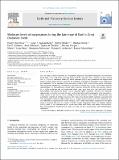Files in this item
Moderate levels of oxygenation during the late stage of Earth's Great Oxidation Event
Item metadata
| dc.contributor.author | Ossa Ossa, Frantz | |
| dc.contributor.author | Spangenberg, Jorge E. | |
| dc.contributor.author | Bekker, Andrey | |
| dc.contributor.author | König, Stephan | |
| dc.contributor.author | Stüeken, Eva E. | |
| dc.contributor.author | Hofmann, Axel | |
| dc.contributor.author | Poulton, Simon W. | |
| dc.contributor.author | Yierpan, Aierken | |
| dc.contributor.author | Varas-Reus, Maria I. | |
| dc.contributor.author | Eickmann, Benjamin | |
| dc.contributor.author | Andersen, Morten B. | |
| dc.contributor.author | Schoenberg, Ronny | |
| dc.date.accessioned | 2022-08-17T10:30:01Z | |
| dc.date.available | 2022-08-17T10:30:01Z | |
| dc.date.issued | 2022-09-15 | |
| dc.identifier | 280912728 | |
| dc.identifier | ba16647b-1f3a-45e2-9a53-c1dbd45ff931 | |
| dc.identifier | 85134890292 | |
| dc.identifier | 000888318100002 | |
| dc.identifier.citation | Ossa Ossa , F , Spangenberg , J E , Bekker , A , König , S , Stüeken , E E , Hofmann , A , Poulton , S W , Yierpan , A , Varas-Reus , M I , Eickmann , B , Andersen , M B & Schoenberg , R 2022 , ' Moderate levels of oxygenation during the late stage of Earth's Great Oxidation Event ' , Earth and Planetary Science Letters , vol. 594 , 117716 . https://doi.org/10.1016/j.epsl.2022.117716 | en |
| dc.identifier.issn | 0012-821X | |
| dc.identifier.other | RIS: urn:0272BB2168DF172D2503ACC5A71C3FAF | |
| dc.identifier.other | ORCID: /0000-0001-6861-2490/work/117568397 | |
| dc.identifier.uri | https://hdl.handle.net/10023/25858 | |
| dc.description | Funding: FOO and RS acknowledge financial support from the University of Tübingen and the German Research Foundation (DFG Grant SCHO1071/11-1). FOO and MBA are thankful for support from the Natural Environment Research Council (NERC grant NE/V004824/1). The stable isotope facilities at IDYST were funded by the University of Lausanne. SK, YA and MIV-R acknowledge European Research Council (ERC) Starting Grant 636808 (O2RIGIN). AH and FOO acknowledge support from National Research Foundation of South Africa (NRF Grant 75892). SK also acknowledges the Ramon y Cajal contract (RYC2020-030014-I). Participation by AB was supported by Discovery and Accelerator Grants from the Natural Sciences and Engineering Research Council of Canada (NSERC) and ACS PF grant (624840ND2). EES acknowledges funding from a NERC Frontiers grant (NE/V010824/1). SWP acknowledges support from a Royal Society Wolfson Research Merit Award. MIV-R additionally acknowledges funding support from the German Research Foundation (DFG Grant VA 1568/1-1). | en |
| dc.description.abstract | The later stages of Earth's transition to a permanently oxygenated atmosphere during the Great Oxidation Event (GOE; ∼2.43–2.06 Ga) is commonly linked with the suggestion of an “oxygen overshoot” during the ∼2.22–2.06 Ga Lomagundi Event (LE), which represents Earth's most pronounced and longest-lived positive carbon isotope excursion. However, the magnitude and extent of atmosphere-ocean oxygenation and implications for the biosphere during this critical period in Earth's history remain poorly constrained. Here, we present nitrogen (N), selenium (Se), and carbon (C) isotope data, as well as bio-essential element concentrations, for Paleoproterozoic marine shales deposited during the LE. The data provide evidence for a highly productive and well-oxygenated photic zone, with both inner and outer-shelf marine environments characterized by nitrate- and Se oxyanion-replete conditions. However, the redoxcline subsequently encroached back onto the inner shelf during global-scale deoxygenation of the atmosphere-ocean system at the end of the LE, leading to locally enhanced water column denitrification and quantitative reduction of selenium oxyanions. We propose that nitrate-replete conditions associated with fully oxygenated continental shelf settings were a common feature during the LE, but nitrification was not sufficiently widespread for the aerobic nitrogen cycle to impact the isotopic composition of the global ocean N inventory. Placed in the context of Earth's broader oxygenation history, our findings indicate that O2 levels in the atmosphere-ocean system were likely much lower than modern concentrations. Early Paleoproterozoic biogeochemical cycles were thus far less advanced than after Neoproterozoic oxygenation. | |
| dc.format.extent | 12 | |
| dc.format.extent | 2878713 | |
| dc.language.iso | eng | |
| dc.relation.ispartof | Earth and Planetary Science Letters | en |
| dc.subject | Paleoproterozoic | en |
| dc.subject | Lomagundi carbon isotope excursion | en |
| dc.subject | Great Oxidation Event | en |
| dc.subject | Francevillian Group | en |
| dc.subject | Biogeochemical cycles | en |
| dc.subject | GE Environmental Sciences | en |
| dc.subject | QE Geology | en |
| dc.subject | NDAS | en |
| dc.subject | SDG 14 - Life Below Water | en |
| dc.subject | MCC | en |
| dc.subject.lcc | GE | en |
| dc.subject.lcc | QE | en |
| dc.title | Moderate levels of oxygenation during the late stage of Earth's Great Oxidation Event | en |
| dc.type | Journal article | en |
| dc.contributor.sponsor | NERC | en |
| dc.contributor.institution | University of St Andrews. School of Earth & Environmental Sciences | en |
| dc.contributor.institution | University of St Andrews. St Andrews Centre for Exoplanet Science | en |
| dc.identifier.doi | 10.1016/j.epsl.2022.117716 | |
| dc.description.status | Peer reviewed | en |
| dc.identifier.grantnumber | NE/V010824/1 | en |
This item appears in the following Collection(s)
Items in the St Andrews Research Repository are protected by copyright, with all rights reserved, unless otherwise indicated.

